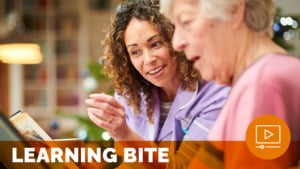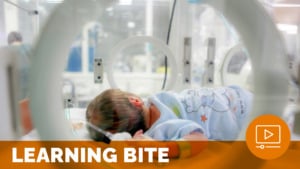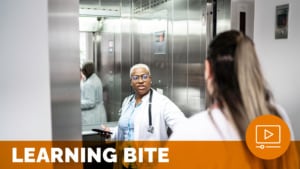Learning Bite
Showing 129–143 of 143 results
-
 Patient Family & Community Engagement | Staff & Provider Engagement
Patient Family & Community Engagement | Staff & Provider EngagementUsing Design Thinking Principles to Reduce Healthcare Barriers & Improve Access
This learning bite brings to light the importance of understanding our patients’ barriers in healthcare. Learn how design thinking can be a tool to improve experience. Through the human-centered approach of design thinking, we can integrate the needs of the people into our processes and procedures that create more equitable experiences for those in our
Learn more -
 Policy & Measurement
Policy & MeasurementUsing Experience-based Design to Understand the Patient and Caregiver Experience with Delirium
Amy London, Product Innovation Specialist, Virginia Mason Medical Center, shares how using experience-based design was an innovative framework to increase their understating of the experience during and following episodes of hospital acquired delirium. Read associated PXJ article
Learn more -
 Patient Family & Community Engagement
Patient Family & Community EngagementUsing Patient/Family Feedback within a Health System
Sharon Cross, Program Manager, Ohio State University Wexner Medical, focuses on various methods to begin utilizing patient/family feedback in healthcare organizations. Mechanisms for feedback may include the creation of an advisory council or holding single meetings, but options vary greatly from one organization to the next depending on the organization size, culture and focus on
Learn more -
 Staff & Provider Engagement
Staff & Provider EngagementUsing the Right Tools to Uncover the Hidden Factors Impacting Patient Experience
The entire healthcare industry is being reshaped by trailblazers who make personal and emotional connections that will define the healthcare brands of the future. Those unwilling to make changes and adapt to the expectations of forward-thinkers will be left behind. This learning bite explains why organizations that prioritize experience transformation through innovative tools and solutions
Learn more -
 Innovation & Technology
Innovation & TechnologyUsing Unsolicited Feedback to Improve Patient Experience
Amy Brown, Founder & CEO, Authenticx, shares the importance of unsolicited feedback compared to traditional surveys and the ways to collect it in order to improve the patient experience.
Learn more -

Volunteers and the Patient Experience
Doug Della Pietra, M.Div., CPXP, Manager, Volunteer and Guest Services at Rochester General Hospital, shares ways to better align volunteers and the volunteer program with an organization’s efforts to improve the patient, family, resident and client experiences.
Learn more -

Want to Engage Physicians? Speak Their Language
Justin Bright, M.D, Senior Staff Physician/Patient Experience Champion at Henry Ford Hospital, shares that the best things we can provide physicians to improve in a sustainable way are purposeful shadowing and communication training.
Learn more -
 Innovation & Technology
Innovation & TechnologyWays to Enhance Communication in Improving the NICU Experience for Families
Lori Gunther, MS, CPXP, Director, Quality and Strategy, NICU Initiatives, March of Dimes Foundation, shares why it’s not just the verbal communication that makes a strong impact on engaging families and addresses ways to improve the experience for families in the NICU by actively seeking their feedback on what made their NICU experience positive and
Learn more -
 Patient Family & Community Engagement
Patient Family & Community EngagementWhat Families Can Teach Us about Patient Experience
D’Anna Holmes, Program Manager, Patient Engagement, Northwestern Memorial Hospital, shares her patient experience journey as a mom and provides three things she’s learned from her experiences to apply every day as a patient experience professional.
Learn more -
 Culture & Leadership
Culture & LeadershipWhat Healthcare Can Learn from Others
Richard Corder, Assistant Vice President for CRICO Strategies, shares from his prior experience in the hotel business industry and how it relates to improving service and safety in healthcare. Richard outlines six key hospitality lessons that are practiced by many other successful industries and is guided by personally accountable leaders.
Learn more -
 Staff & Provider Engagement
Staff & Provider EngagementWhat is Projective Identification, and Why Should I Care?
We’ve all had an experience dealing with someone who is upset or angry. In these uncomfortable situations, it is sometimes difficult to know where the discomfort comes from—us or the other person. The projection of negative feelings from one person into another is what psychiatrists call “projective identification.” In this learning bite, Helen Riess, M.D.,
Learn more -
 Patient Family & Community Engagement
Patient Family & Community EngagementWhat is social prescribing?
Prince Taylor, Deputy Director, VA Center for Development and Civic Engagement, discusses loneliness and its negative impact on our health and how social prescribing can change provide non-medical intervention and positively effect patient outcomes.
Learn more -
 Policy & Measurement
Policy & MeasurementWhy HCAHPS is Not Just an Inpatient Initiative
Jan Gnida, Director, Patient Experience & Government Surveys, Professional Research Consultants, discusses how HCAHPS may give healthcare organizations the framework for the patient experience conversation, but the reach goes beyond just those who have direct patient contact.
Learn more -
 Culture & Leadership
Culture & LeadershipWhy Patients Come Second
Paul Spiegelman, Founder of The Beryl Institute, provides insight from his book, “Why Patients Come Second,” and presents three key elements to improving the patient experience by creating a foundation of great organizational culture.
Learn more -
 Patient Family & Community Engagement
Patient Family & Community EngagementWhy Should We Care “What Matters Most” to Our Patients and their Families?
Mary Ann Dragon, Director, Patient and Family Services, Rainbow Babies and Children’s’ and MacDonald Women’s Hospitals University Hospitals, discusses why we should care about what matters most to patients and families. Communicating and making connections show us how to individualize care to support patient and family engagement and participation in the plan of care.
Learn more